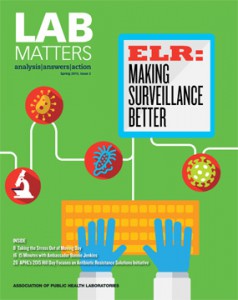 The Electronic Laboratory Reporting (ELR) system at the Wisconsin State Laboratory of Hygiene (WSLH) is featured in the latest issue of the Association of Public Health Laboratories Lab Matters magazine.
The Electronic Laboratory Reporting (ELR) system at the Wisconsin State Laboratory of Hygiene (WSLH) is featured in the latest issue of the Association of Public Health Laboratories Lab Matters magazine.
ELR involves sending laboratory test result information electronically rather than via paper reports. This speeds up the ability for public health departments to respond to potential disease outbreaks.
The WSLH has established ELR for test results from Wisconsin patients with reportable conditions such as measles, TB and E. coli O157:H7. The WSLH IT system is connected with systems at 52 hospital laboratories in Wisconsin and 5 national laboratories in order for those labs to send test results to the WSLH. Another 24 hospital labs in Wisconsin, Minnesota and Ohio send results via a secure web portal.
After being assigned identifier codes, these test results are sent via a secure system to the Wisconsin Electronic Disease Surveillance system (WEDSS), where staff at local health departments and the Wisconsin Division of Public Health (WDPH) can view the results and respond as needed to prevent further disease spread.
The WSLH also electronically reports results from tests it performs to the Centers for Disease Control and Prevention (CDC) for a variety of infectious disease pathogens. This is part of efforts by WSLH, WDPH and CDC to monitor what may be sickening people and where.
It was through these surveillance efforts, that WSLH and WDPH staff discovered cases of “flumps” last year. The story is recounted in the article by Bill Bellini, chief of CDC’s Measles, Mumps, Rubella and Herpes Viruses Laboratory Branch.
Last year, near real-time surveillance was responsible for identifying a possible new syndrome associated with influenza H3fluA. Clusters of patients with cold-like symptoms and clinical parotitis (swelling of the major salivary glands) were thought to have mumps. Said Bellini, “Finally, someone in Wisconsin had the bright idea to put [the suspected mumps specimens] through their respiratory panel, and it turned out to be H3flu.”
Dissemination of this finding had important public health implications: “It changes people’s mindset. Although the frequency of parotitis-associated H3fluA infections is still being evaluated, you have to start thinking about contacts and rapid follow-up, because flu spreads like wildfire.”
